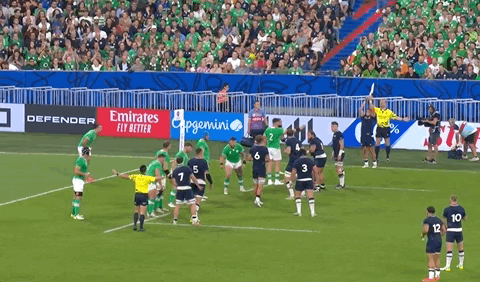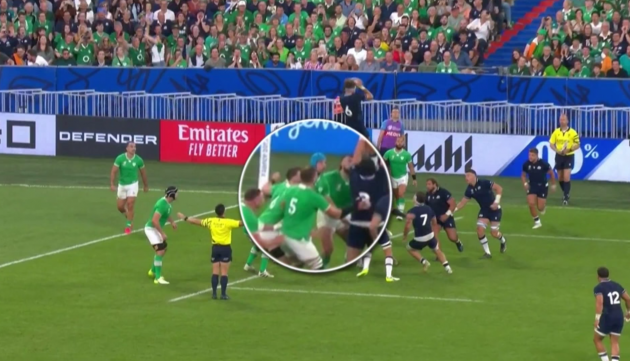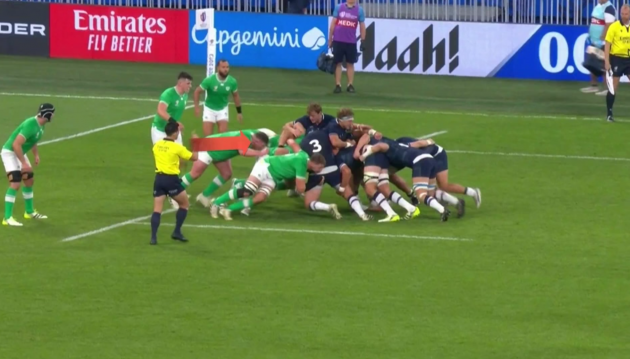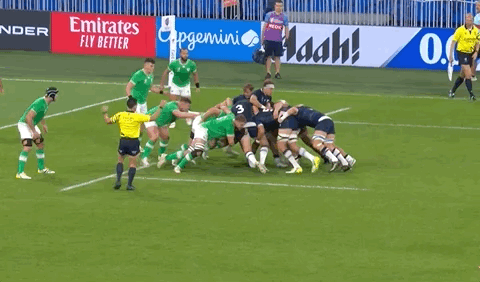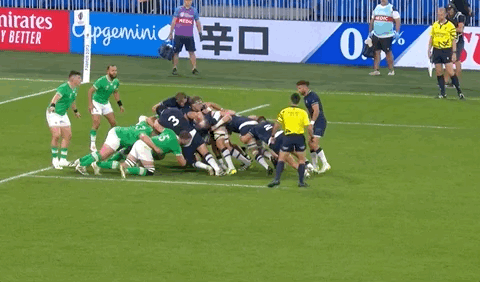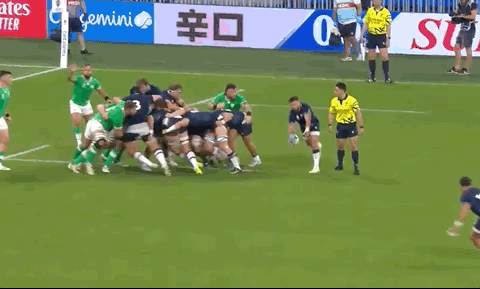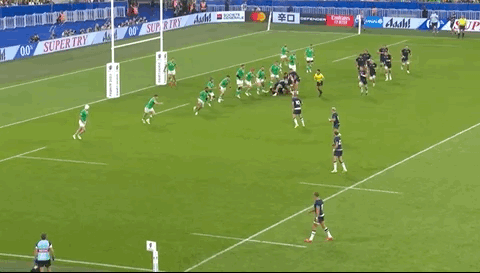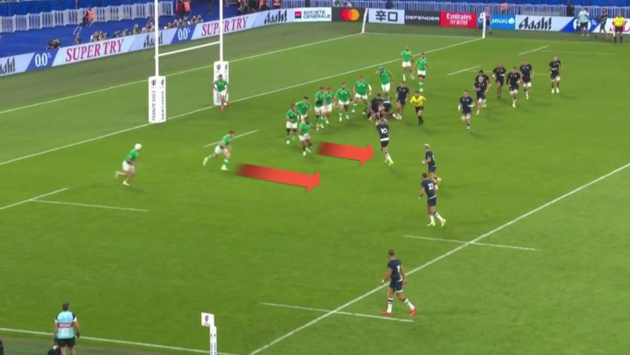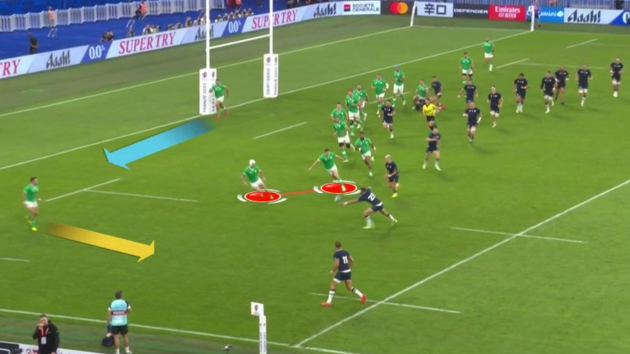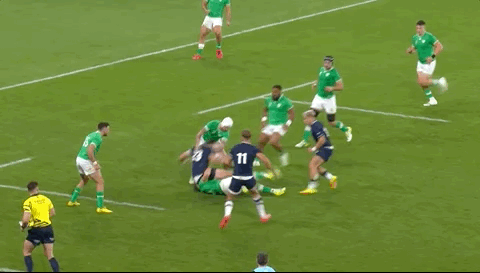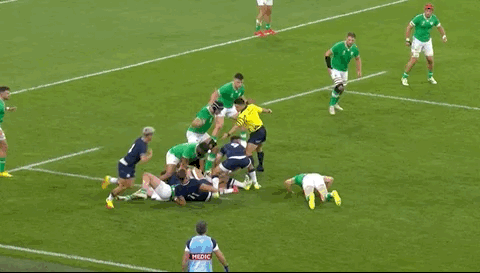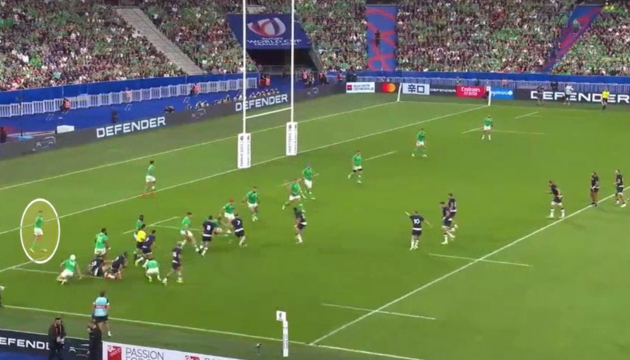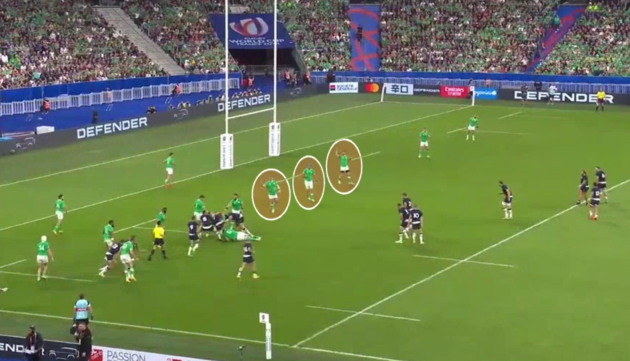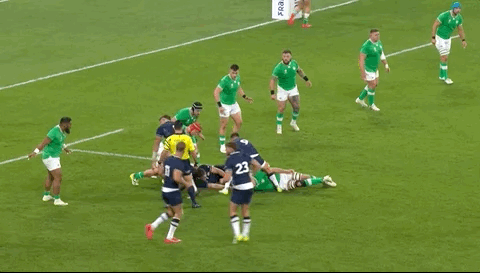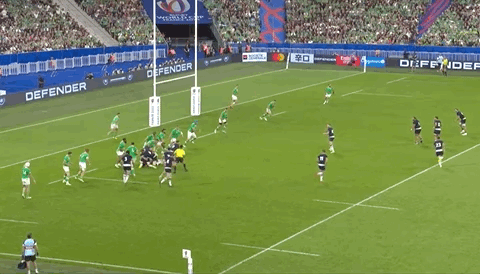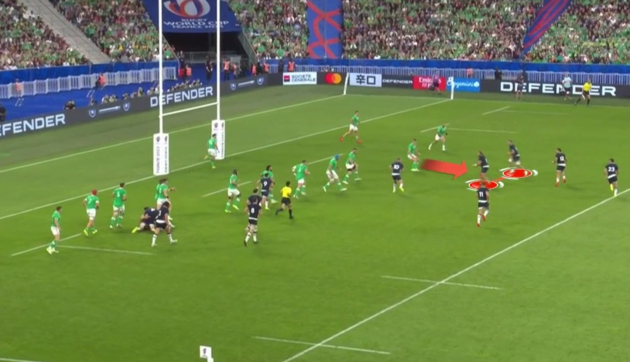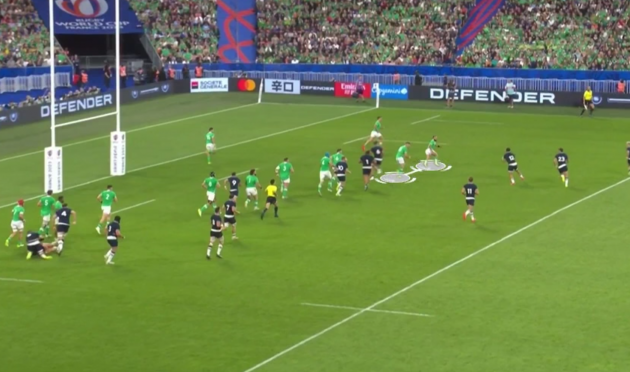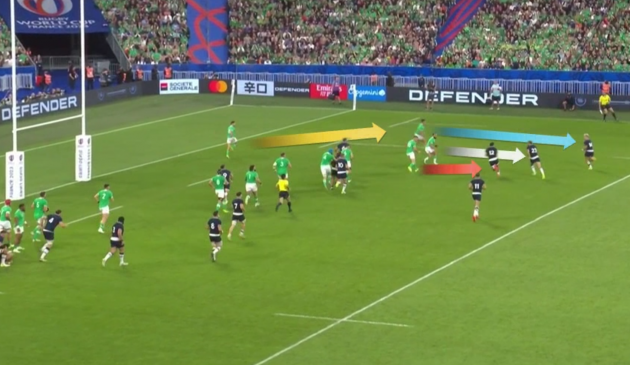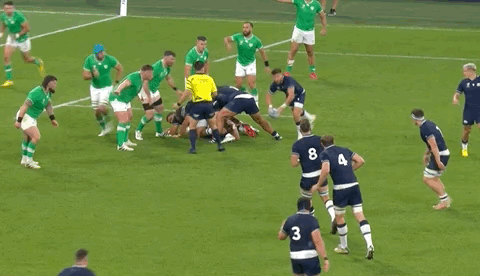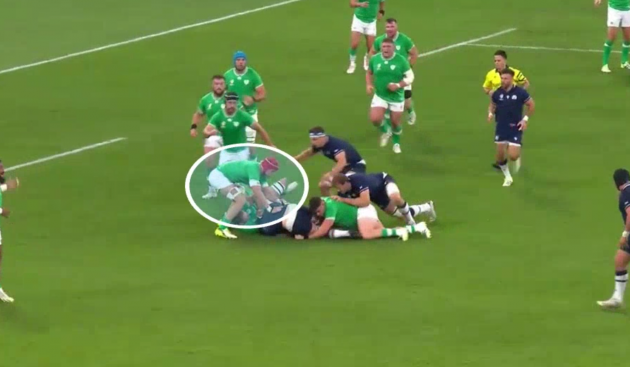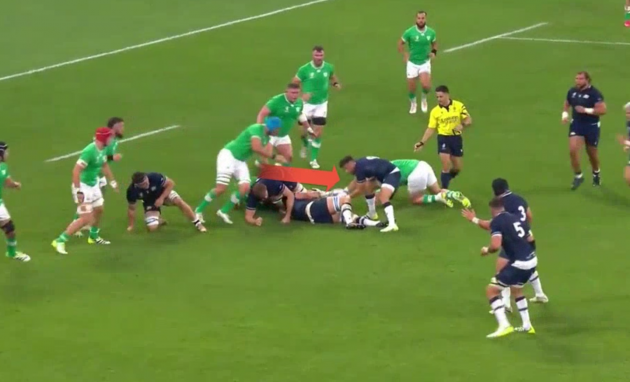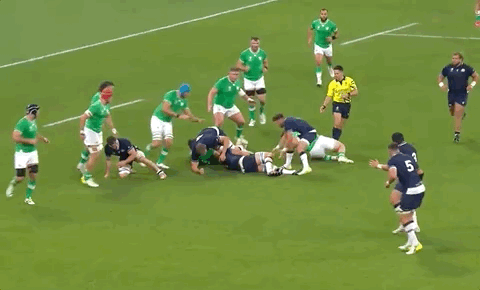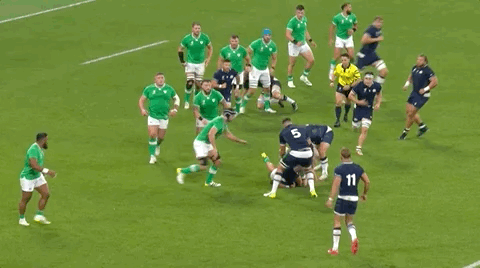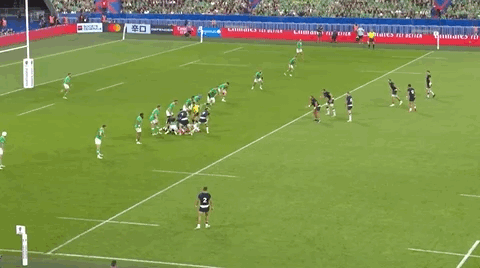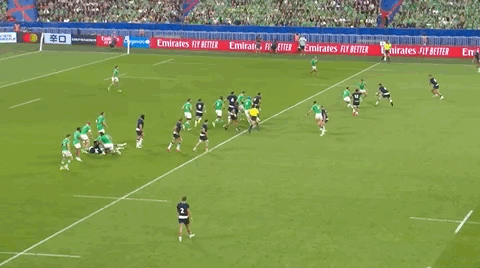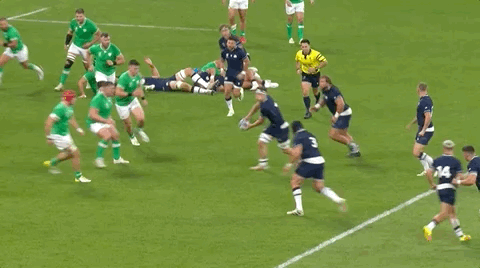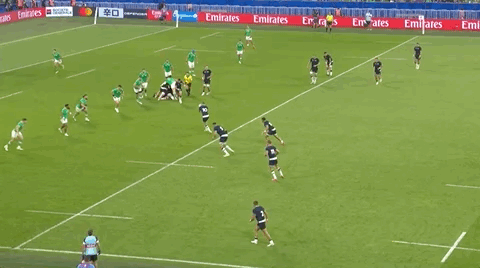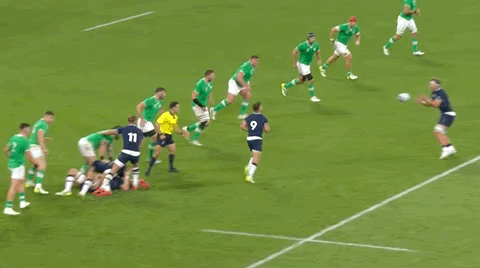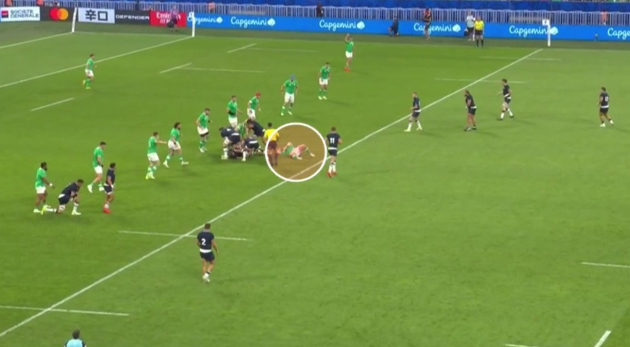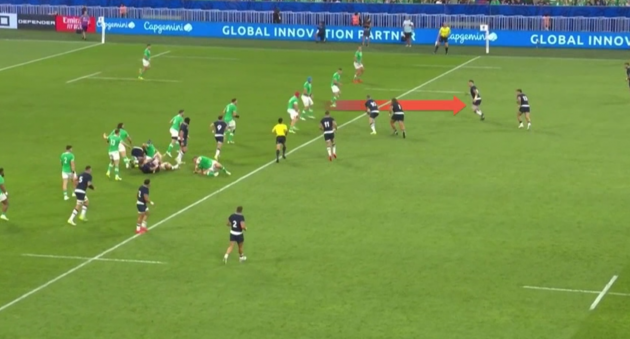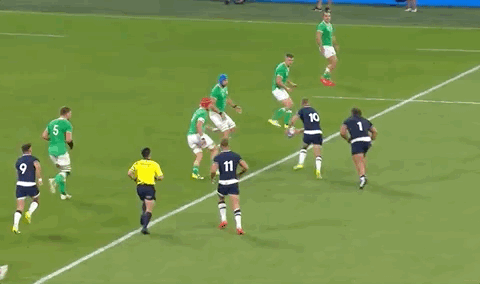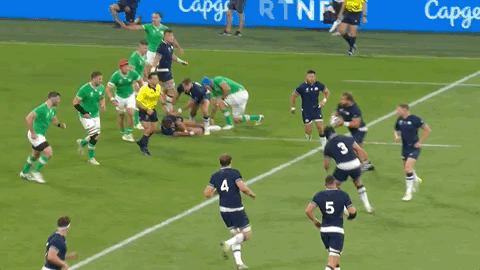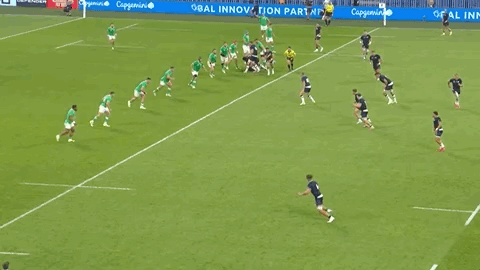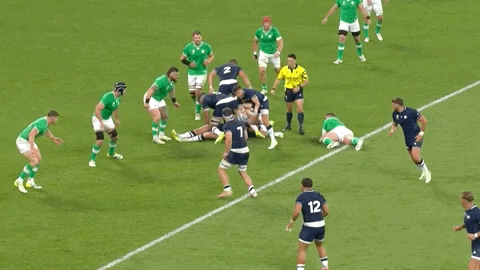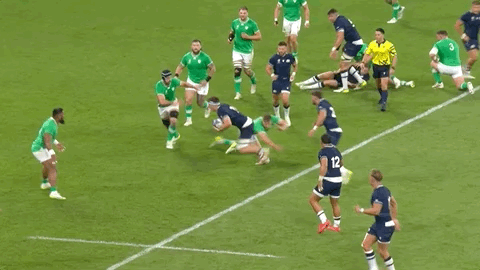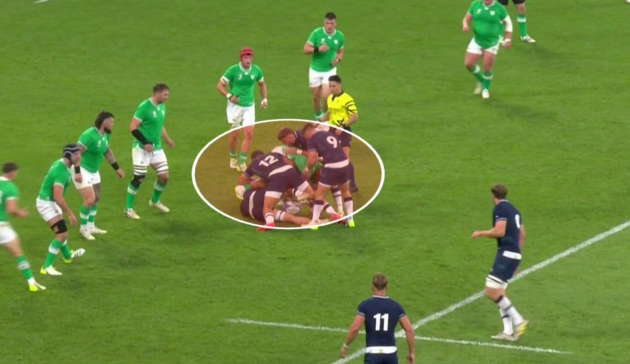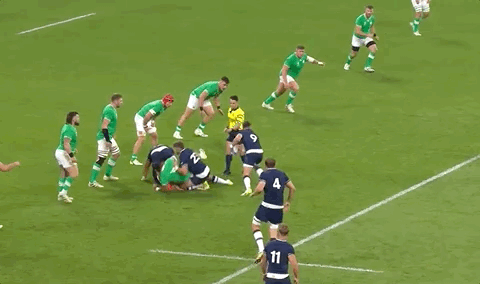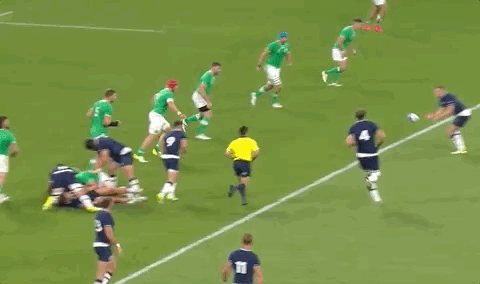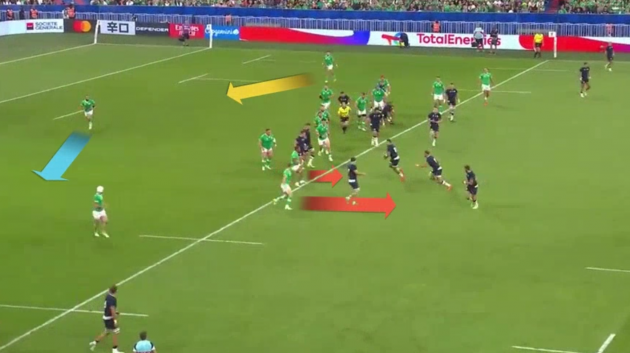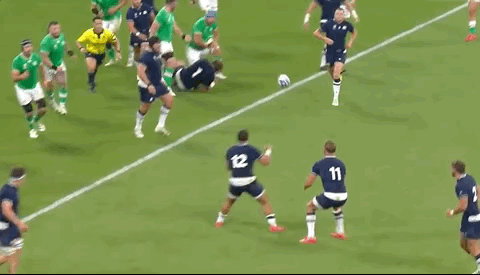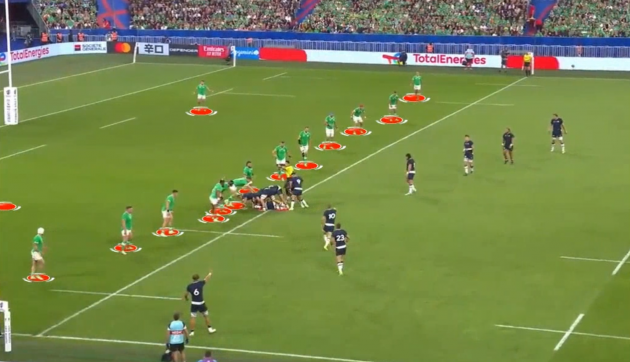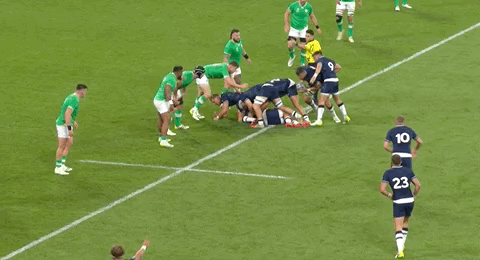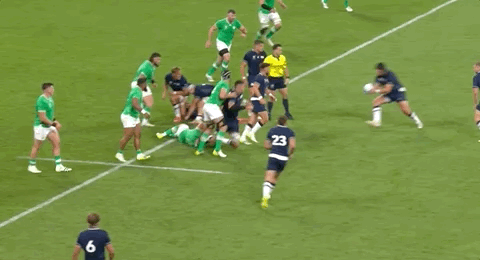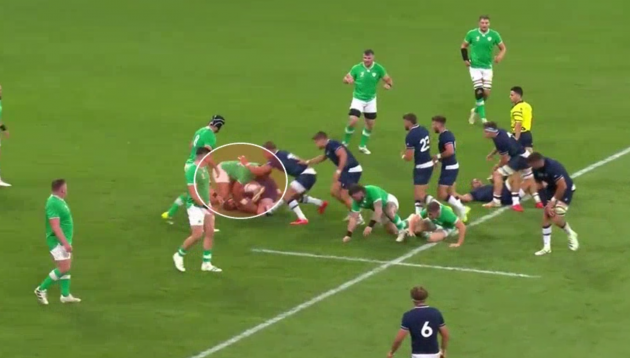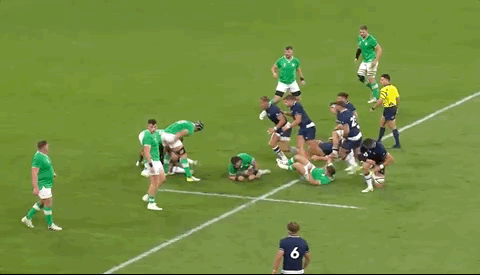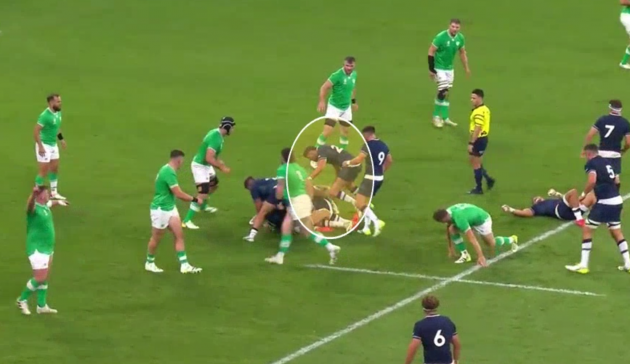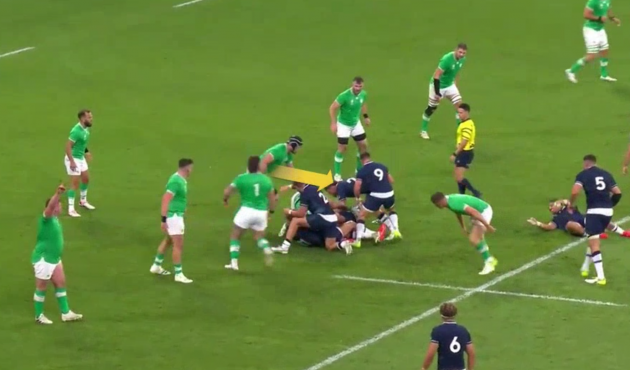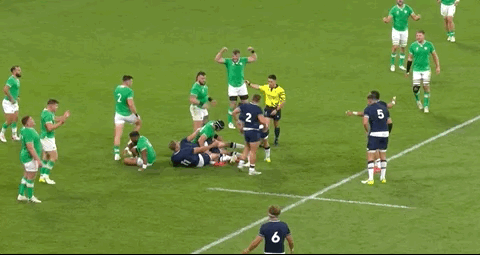THIS IRELAND TEAM have deservedly become known as one of the most intelligent and efficient attacking teams in rugby but they take equal pride in their defence.
Last night in Paris, they had to do plenty of defending. Andy Farrell’s men attempted more than 200 tackles in a game that had a ball-in-play time of 38 minutes and 23 seconds, according to Opta’s data. Those are high numbers.
Although Ireland conceded two tries to a Scottish flurry when the game had already been decided as a contest, they were largely superb in defence.
With Caelan Doris and Josh van der Flier leading the way with 22 tackles each, there was a relentless edge to the Irish defence that bodes well before they face New Zealand, a hugely dangerous attacking team, in next weekend’s World Cup quarter-final.
One particular defensive passage stood out last night in Paris. Having scored after just 63 seconds of the game, Ireland were then pinned deep into their own half for the next 10 minutes.
The Scots left empty-handed, though, as Ireland’s defence fronted up impressively. The key passage was an 18-phase grandstand that began with a five-metre Scotland lineout and rolled on for a punishing two minutes and 30 seconds.
That is a huge amount of ball-in-play time for one passage in a game. The average passage at this World Cup has been 27 seconds, so it’s clear how deep Ireland had to dig to repel the Scots.
It was a monstrous psychological win for Ireland and equally as damaging for Gregor Townsend’s side. Even at the time, so early in the contest, it felt like the winning of the game for Ireland and that sense was only strengthened by what followed.
The passage starts with a Scottish five-metre lineout, which they would have viewed as a big try-scoring chance at this stage of the game, 11 minutes in. Instead, Irish defence coach Simon Easterbey’s charges delivered a remarkable grandstand.
Ireland’s maul defence was superb last night and this is a fine example of how they shut the Scots down.
Ireland were very selective with their competition at the lineout. They only competed in the air on Scotland’s throw twice, with Peter O’Mahony making steals on both occasions. Otherwise, they stayed on the ground to negate the Scottish maul.
That’s the case here as Ireland focus on nailing their maul defence rather than getting in the air and leaving themselves less organised to make an early dent on the Scottish maul.
Note how O’Mahony and Tadhg Beirne bind onto each other, with Andrew Porter and Iain Henderson then also binding on either side of that pair.
It’s almost like a four-man front row for Ireland. O’Mahony and Beirne’s focus is on splintering into the seams between lineout jumper Jamie Ritchie and his two lifters.
Porter and Henderson focus on destabilising those lifters in the same split second as Ritchie lands back on the ground, meaning they collectively unsettle the whole front edge of the Scottish maul.
Ireland win this contest early and then Tadhg Furlong joins to lend his power and weight to the mix to hammer the advantage home.
There are actually eight Scottish forwards in the maul here and only five Irish forwards, but the excellent early work means the Scots can’t generate any forward momentum.
It takes savage strength and endurance from the Irish forwards to maintain the pressure, though. Mauling is incredibly physically demanding. Forwards’ legs burn and their lungs scream in these incredibly intense moments of physical contest.
Just as Furlong joins, referee Nic Berry tells Scotland, “Yep, backwards once,” as an early warning that they need to either move forward or shift the ball away from the maul.
Ireland’s forwards continue their defensive effort and Berry says, “OK, we’re going to get ready to use it. I need to see it moving forward.”
Still, there’s no progress for Scotland and Berry runs out of patient as he says, “OK, nine [scrum-half Ali Price], get going now.”
Price passes away to the left to conclude a big maul win for the Irish pack.
Being driven backwards at the maul places a big emphasis on the first Scottish carry and they go to inside centre Sione Tuipulotu in a bid to win the gainline.
As he did repeatedly in this game, Tuipulotu looks for Ireland out-half Johnny Sexton with his carry, backing himself to win the collision against the 38-year-old.
But as was also repeatedly the case, Ireland openside Josh van der Flier was on the case alongside Sexton. As we see above, van der Flier drops in low around Tuipulotu’s legs to stop him as Sexton wraps around his upper body and then makes a brief counter-ruck effort after the tackle is complete.
The Scots, as they tend to do, look for width immediately on second phase but Ireland manage them well.
We can see Ireland’s desire for linespeed here. They’re eager to keep driving Scotland backwards and so, the first few steps from centres Bundee Aki and Garry Ringrose are upfield at pace. They don’t want to give Scotland any extra time on the ball.
As Scotland out-half Finn Russell throws a skip pass beyond centre Huw Jones to fullback Ollie Smith, Ireland have to adjust, with Aki and Ringrose shifting towards the touchline and ‘jockeying’ or drifting across the pitch.
As highlighted in red above, right wing Mack Hansen has stayed connected with Ringrose on his inside. They’re working in tandem with similar movements forwards and then sideways to adjust for the pass.
Meanwhile, fullback Hugo Keenan [yellow above] is closing up from the backfield to take the last attacker, with Ireland left wing James Lowe [blue] swinging across from the other side of the pitch to fill the space Keenan is vacating.
Smith gathers Russell’s pass on the juggle and while Hansen makes the initial contact, it’s evident how hard Ringrose is hunting from the inside as he drives into the tackle to bring Smith to ground.
That means Hansen can fight for a turnover.
As we can see above, Scottish wings Darcy Graham and Duhan van der Merwe have to hurry to remove the threat of Hansen, with both arguably coming from a side angle.
Even though Hansen is taken out, his effort slightly slows up the Scottish possession and gives Ireland another split second to organise themselves for third phase.
This time, Iain Henderson chops in low on Rory Darge as van der Flier targets the ball, slowing down the recycle speed by holding Darge up off the ground briefly.
As Darge goes to carry, we get a glimpse of Ireland’s precise communication in defence.
Keenan [yellow below] is dropping into the backfield again and he calls for Hansen to get back to his feet and fill the right edge of the frontline defence.
Over on the openside of the frontline, we can see Furlong, Beirne, and O’Mahony [red below] calling and signalling for a ‘fold’ to that side. Essentially, they want more Irish defenders to get to their side of the ruck so they’re not left numbers down.
The next split second sees Lowe [blue below] signal to Keenan that he needs to start moving across to the left-hand side of the backfield as Lowe begins to swing back out towards the left edge of the frontline defence.
At exactly the same moment, Keenan [yellow above] is shouting to Hansen and Ringrose that he’s going to take off for the left-hand side of the pitch and that they need to be aware of him leaving.
It’s obviously very noisy in the stadium so players often can’t actually hear each other even as they roar these snippets of ‘micro chat’ to each other, meaning that physical signals and a true understanding of the defensive system are crucial. This is also the kind of area where the cohesion of a team is most evident.
Moving back to what’s happening on the ball, Scotland hooker George Turner produces a fine carry on fourth phase to eke out some gainline progress for his team.
Even with a double tackle from Porter and Sheehan, who has folded around the corner along with Caelan Doris, Turner wins the collision and allows Scotland a rapid recycle.
Again, they quickly look to get the ball to width but Ireland defend the situation well.
Again, we can see that Ireland bring good linespeed initially as Russell receives the ball from Price.
Sexton has a pod of two Scottish forwards in front of him, as highlighted below.
But Gibson-Park outside Sexton needs his out-half to work beyond those Scottish forwards if the ball from Russell goes out the back, as is the case.
As Sexton reads the pass from Russell and turns off the linespeed to begin jockeying across the pitch, Gibson-Park does a good job of making sure he doesn’t get disconnected from Sexton by flying off on a solo mission.
That means they’re nice and connected as Tuipulotu gets the ball from Russell.
And having initially hoped for a numbers-up situation wide on their right, the hard-working Irish defence means the Scots don’t get that.
Sexton [red above] has Tuipulotu, Gibson-Park [white] is able to address Smith, Lowe [blue] is closing up onto Graham, while Keenan [yellow] is working across to take the last attacker, Jones, who is out of shot above.
Smith realises it’s not on wider out and ducks back inside, slipping into the tackle of Sexton.
Scotland now bounce back infield and it’s number eight Jack Dempsey who carries on sixth phase.
Sheehan goes low as Henderson tackles his upper body, with Scotland once again failing to get over the gainline.
As Sheehan and Henderson bring Dempsey to ground, van der Flier initially looks like he will attempt the turnover.
As a result, Scottish duo Darge and Richie Gray hurry to get to van der Flier for a clearout but the Irish openside actually backs off and both Scots fall off their feet.
While van der Flier’s dummy means the Scots won’t be penalised for not staying on their feet, it also means there’s no one in front of scrum-half Price to protect him as he lifts the ball.
Beirne sees the open door and rushes forward as Price scoops the ball.
As we see below, Price manages to get the ball away to Graham but van der Flier thunders forward to tackle him for another big Scottish loss of metres.
Doris hammers into Grant Gilchrist on the counter-ruck, with Porter joining just behind him and van der Flier popping up onto his feet too.
Ireland don’t successfully turn them over but it’s slow, scrappy ball for the Scots, who are now a good 10 metres back from where they started.
Even after a big gainline loss, Scotland still use their passing game to probe for an opening on the next phase as Price, Pierre Schoeman, and Russell shift the ball to Dempsey…
… who completes the four-pass sequence by tipping the ball on for Jones to accelerate into a sliver of space and step Gibson-Park before he’s grounded by Beirne hunting from inside.
Scotland carry to the left on ninth phase as Darge tips a pass on to tighthead Zander Fagerson, who is well dealt with by van der Flier and Furlong.
Watch below how van der Flier and Furlong look for the choke tackle.
Darge manages to get his knees to ground, though, and referee Nic Berry roars, “Tackle, release!” with the Irish duo responding to avoid giving up a penalty.
Still, their effort has slowed up the Scottish ball before the recycle and the Irish defence makes progress on 10th phase as Gilchrist nearly knocks on a Russell pass.
Scotland then bounce back to their right with captain Ritchie carrying off Price, but he’s met by a superb Irish tackle.
It’s Furlong who hammers in with a chop tackle to stop Ritchie on the spot.
Furlong then shows good discipline post-tackle to roll away from the ball and not risk getting caught offside by Price by getting up off the ground and into his passing channel.
Left in a position where we often see props getting up from and then being on the receiving end of the opposition scrum-half passing into them to buy a penalty, Furlong just stays rooted to the ground.
Ireland only conceded seven penalties in this game, with their discipline continuing to be a key strength.
Beirne plays a crucial role on 12th phase as Scotland once again fail to go forward.
Initially, Beirne is communicating for the fold to give Ireland more bodies on that side of the defensive frontline.
As Russell receives Price’s pass, Beirne has to worry about the front-door option of Dempsey outside Russell.
But as Russell again goes out the back to Jones watch how Beirne shows his mobility and agility to accelerate beyond Dempsey and into a position to make a low tackle on Jones.
On the next phase, O’Mahony follows up with a brilliant chop tackle on Schoeman.
The Ireland blindside dips at a late stage to take out Schoeman’s legs, getting a wrap with his left arm to ground him.
As Scotland desperately search for a chink in the Irish armour, Russell has a dart on 14th phase.
But he’s met with a strong double tackle from Sheehan and Furlong, who again rolls clear to avoid any danger of a penalty.
There’s a missed tackle from Ireland on 15th phase as Darge’s footwork beats Ringrose.
But Ireland have Ringrose covered as Doris and Aki react well to tackle Darge.
With Doris stretching to go in low on Darge, Aki is up high and he does an excellent job of staying on his feet to offer a threat over the ball post-tackle.
Aki’s efforts here obviously slow down the Scottish recycle as Smith and Tuipulotu have to deal with the Irish centre before Price can pass away to the right.
And that means Ireland are well set to defend the next Scottish carry.
It’s hooker Turner who puts his hand up on 16th phase but once again, Furlong and Sheehan combine for a big tackle.
It nearly goes without saying that while this might seem simple enough, it’s hugely taxing defensive work 16 phases into a defensive set that started with a big maul defence.
Even though this is early in the game, the Irish conditioning is important in helping them to deliver back-to-back-to-back efforts like we’re seeing here.
Yet another impactful double tackle from Ireland nearly forces the turnover on 17th phase as Beirne and O’Mahony power into Schoeman.
They dislodge the ball but Dempsey does well to reel it in and pop it away to Russell.
The Scottish out-half turns infield looking for space but Ireland are alert to the danger, even under fatigue.
Ringrose and Aki [red below] close up towards the right edge of Ireland’s frontline, narrowing Tuipulotu’s options as he receives the ball from Russell.
This shot also allows us to see that Ireland are still working hard in the backfield too. Gibson-Park [blue above] is accelerating across from the left-hand side to cover kick space, with Keenan [yellow] starting to drop off the left edge.
Throughout this passage, Ireland’s hard work off the ball meant there was no obvious kick space for Scotland. The Scots will likely reflect that they still could have kicked as they continually failed to break the gainline. There was possibly a stubbornness there, a belief that they could find a way through Ireland. The Scots were turned over by the Springboks for a try in similar circumstances in their opening World Cup game.
But Ireland’s defensive organisation and effort meant there was no invitation for the Scots to kick. In this instance, with his options limited, Tuipulotu carries the ball.
Ireland don’t even have to tackle him as he trips over team-mate van der Merwe just before Aki gets to grips with him.
The Scots are clearly running short of ideas now and Ireland finally strike for the kill on 18th phase.
Firstly, it’s worth noting how strong a position they’re in even after all of this defending.
As Scotland get set to play, all 15 of Ireland’s players are on their feet ready to defend.
This is a fine habit they have developed under Easterby and again speaks volumes of their good conditioning. While Ireland clearly do attack the breakdown with jackaling and counter-rucking, they’re very strong decision-makers and rarely waste bodies chasing lost causes.
There are four Scottish players in the breakdown, with another two at the back of it.
It’s a jarring image and Ireland earn the turnover at the end of this next phase.
Gilchrist opts to pick and carry but he’s met by a powerful double tackle from Ringrose and Doris.
Gilchrist loses the collision and decides to fire an offload to Fagerson, who accelerates into the space just vacated by Ringrose and Doris.
He might briefly feel he’s heading for a happy place but Porter drops him with yet another excellent Irish chop tackle.
Porter’s fine tackle allows Aki to once again threaten over the ball as he jackals.
The threat of Aki means the first and second arriving Scots, van der Merwe and Turner, are both focused on clearing him away.
And that leaves Smith as the only Scottish player on their feet at the breakdown.
The Scotland fullback is upright as he arrives and has his head down towards the ground, rather than scanning and bracing for any counter-ruck.
Doris, having worked back around from his tackle on Gilchrist, sees the opportunity and blasts into Smith on the counter-ruck.
This is becoming a big part of Doris’ game, with another big counter-ruck turnover against South Africa.
In this instance, he drives Smith backwards into Price just as he lifts the ball to try and launch the 19th phase of attack, knocking it loose of Price’s grip.
Referee Berry blows his whistle and signals the knock-on.
Ireland’s delight is clear, as is their fatigue after two-and-a-half minutes of defending.
The Scots, meanwhile, are broken.
They have thrown everything at Ireland across this passage and the preceding minutes but have been left empty-handed.
It’s still only the 14th minute of the game but it proves to be their last real occupation of Irish territory of this nature.
By half time, Ireland lead 26-0 and it’s game over.


